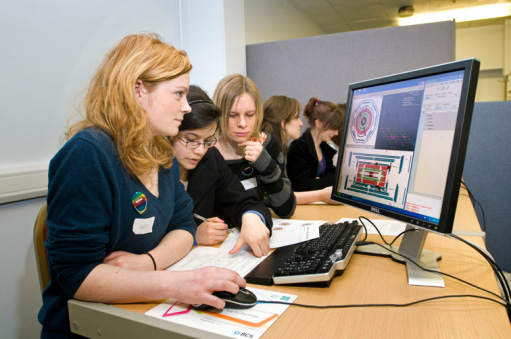
ATLAS e-News
23 February 2011
Outreach - "Higgs Hunters for the Day!!"
13 May 2008

School students get a taste of particle physics at the RAL MasterClass, scanning simulated ATLAS events and hunting for the Higgs boson.
Nearly 500 high school students, accompanied by their teachers, visited the Rutherford Appleton Laboratory (RAL) over three days at the end of March this year, touring the RAL accelerator facilities and learning first hand about the concepts, techniques and goals of particle physics. MasterClasses take place at most UK institutes involved in particle physics and are part of an established European MasterClass programme, whose aim is to support and supplement the teaching of particle physics to high school students. The RAL MasterClass has been running successfully for eleven years now.
With the upcoming LHC start-up, this year's RAL MasterClass had a strong focus on the LHC and on ATLAS specifically, as one example of an LHC detector. There was not only a dedicated LHC lecture, but also a customized ATLAS-based hands-on exercise using Monte-Carlo events displayed using the official ATLAS visualisation programme ATLANTIS.
Each group of students had to look at a different set of events and classify them in different categories, e.g. distinguishing W or Z bosons decaying in the electron or muon channels. Just to spice things up further, it was arranged that one of the event sets would include a simulated Higgs boson decay. Searching for this event in the full sample turned out to be a big focus of interest, especially since we had announced a prize for the sharpest-eyed groups. Even some of the teachers could not resist the challenge and joined the Higgs hunt in a bid to outdo their students!
Of course, all the students had to start out analysing their assigned event sample. With the help of our tutors they quickly learned how to identify electrons, muons and jets in the detector, classifying each event as W/Z, (or Higgs!) signal or QCD-jet background. Amazingly, even after only a few events already, most students were seen to be scanning in a confident and professional way. Surprisingly also, almost no one had any difficulties using the ATLANTIS display and they happily "clicked" around, accessing the various features to display track momenta, jet energies, and zooming the detector views in and out!
Once they finished scanning their own events, they typically eagerly continued scanning on the full sample in the hope of finding the Higgs. At the end of the exercise we collected the results from each group and analysed them all together. In an appropriately ceremonial way the successful Higgs discoverers then received their prize in the form of an ATLAS 3D-viewer!!
Not only the students, but also the teachers and tutors appeared to enjoy themselves. In the feedback questionnaire under the category "what was the most interesting thing you learned during the day?” we had comments from the teachers such as "How using detectors allows you to work out what particles are produced!" or "The computer exercise was best thing this year - and a prize too!!".
For quite a few students the highlight was "using ATLANTIS and how to detect electrons, muons etc in the ATLAS detector". One student brazenly declared "I am good at finding the Higgs particle!!". Another (no less modest!) claimed "I learned everything about the Higgs - the Higgs boson decays in two electrons and two muons!!". While this last is perhaps not the whole picture scientifically speaking, it surely does illustrate well that our ATLAS exercise has done a good job this year in capturing interest and inspiring confidence and enthusiasm.
We look forward to running the exercise again next year, for a new generation of students. Then hopefully we will be using 'real' data, although probably still not yet with a 'real' Higgs event - for this we will all probably have to wait a little longer!!
|
Alessandro TricoliRutherford Appleton Laboratory |
Monika WielersRutherford Appleton Laboratory |
Bill ScottRutherford Appleton Laboratory |


